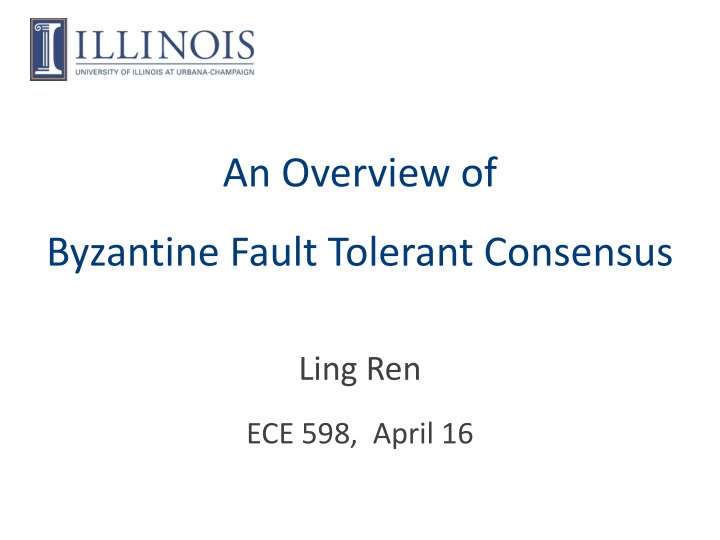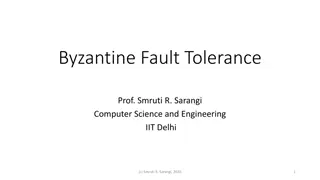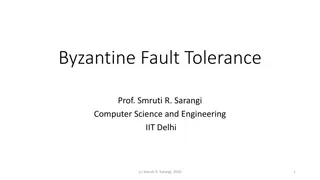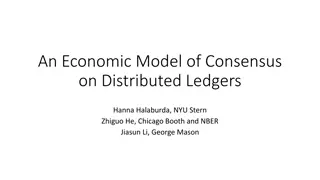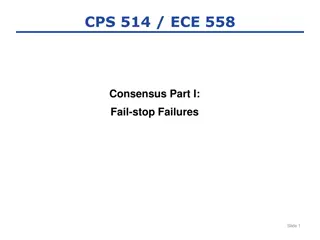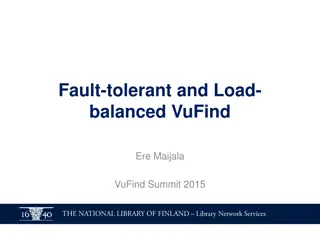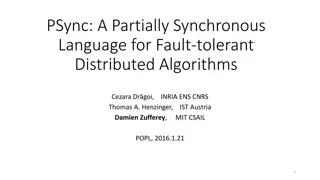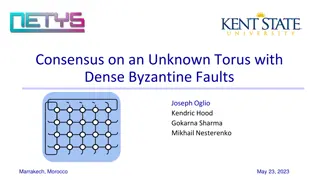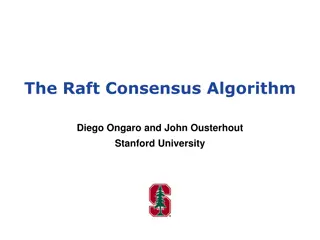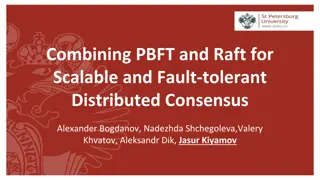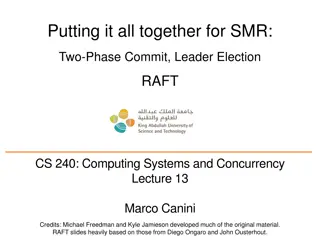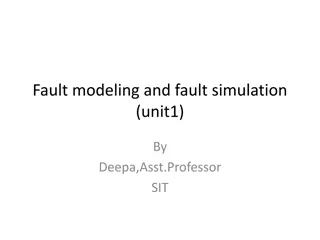An Overview of Byzantine Fault Tolerant Consensus
"In this overview, explore the fundamental problem of consensus in distributed computing, covering safety, liveness, fault types, research advancements over 40 years, well-known results, and the Sync HotStuff protocol. Delve into the complexities and models of achieving fault-tolerant consensus in various network settings."
Download Presentation

Please find below an Image/Link to download the presentation.
The content on the website is provided AS IS for your information and personal use only. It may not be sold, licensed, or shared on other websites without obtaining consent from the author.If you encounter any issues during the download, it is possible that the publisher has removed the file from their server.
You are allowed to download the files provided on this website for personal or commercial use, subject to the condition that they are used lawfully. All files are the property of their respective owners.
The content on the website is provided AS IS for your information and personal use only. It may not be sold, licensed, or shared on other websites without obtaining consent from the author.
E N D
Presentation Transcript
An Overview of Byzantine Fault Tolerant Consensus Ling Ren ECE 598, April 16
So Far in the Course A deep dive into Bitcoin and its variants Nakamoto consensus (PoW and longest-chain-wins) Today: non-Nakamoto consensus Overview of 40 years of research A latest protocol: Sync HotStuff A quick comparison 2
Consensus One of the most fundamental problems in distributed computing [Pease-Shostak-Lamport,1980] Target application: replicated service Provide an abstraction of a single non-faulty server Safety (consistency): all nodes commit the same sequence of values Liveness: keep committing new values 3
Many Faces of Consensus How is the consensus problem defined? Replication / Broadcast / Agreement / Is every pair of node connected? Yes / No (static or dynamic?) Is there a bound on message delay? Synchrony (Yes) / Asynchrony (No) / Partial Synchrony (Sometimes) What types of faults? Crash / Byzantine / 4
40 Years of Research Pick a problem and a model Design protocols with lower latency, less communication, higher fault tolerance Prove impossibility and lower bounds A myriad of results, complicated and subtle, sensitive to seemingly minor changes in model 5
Some Well-known Results Fault tolerance bounds of replication n nodes in total, f nodes are faulty Synchrony Partial synchrony Primary-backup Paxos Crash f < n f < n / 2 Today PBFT/HotStuff Byzantine f < n / 2 f < n / 3 Deterministic asynchrony f = 0 Randomized asynchrony same 7
Sync HotStuff: Simple and Practical Synchronous State Machine Replication Ittai Abraham Dahlia Malkhi Kartik Nayak Ling Ren Maofan Yin
Model How is the consensus problem defined? Replication / Broadcast / Agreement / Is every pair of node connected? Yes / No (static or dynamic?) Is there a bound on message delay? Synchrony (Yes) / Asynchrony (No) / Partial Synchrony (Sometimes) What types of faults? Crash / Byzantine (n = 2f + 1) / Public key setup; all messages are signed 9
Sync HotStuff Overview Leader proposes x (signed) Upon receiving the first proposal, each node forwards and votes for the proposal Commit x if nothing bad happens within 2 n = 2f+1 Node 1 (leader) Node 2 | | 2 | | | | 2 | | Node 3 10
Sync HotStuff Overview Propose, forward/vote, commit after 2 If leader does not misbehave (nothing bad happens), every honest node votes for the same value We say f+1 (signed) votes form a certificate Repeat View (leader) change if the leader misbehaves Alice pays Bob $10 Alice pays Dan $22 Dan pays Carol $50 Carol pays Bob $50 Dan pays Bob $30 Bob pays Alice $10 Cert Cert Cert 11
What Misbehavior or Bad Things? Leader equivocation stops a commit Both proposals are signed by the leader Why 2 Node 1 (leader) Node 2 | | 2 | | | | 2 | | Node 3 12
What Misbehavior or Bad Things? Leader equivocation stops a commit Both proposals are signed by the leader Why 2 t | | 2 | | Node 2 t+ 13
What Misbehavior or Bad Things? Leader equivocation stops a commit Leader equivocation also triggers a view change Forward (signed) equivocating proposals to all Proof of misbehavior t | | 2 | | Node 2 t+ 14
What Misbehavior or Bad Things? Leader equivocation stops a commit Leader equivocation also triggers a view change Lack of progress triggers a time-out (blame) f+1 blames trigger a view change View change on provable leader misbehavior Forward proof of misbehavior and quit view stop commit countdown Wait for before entering new view honest nodes won t be split into two views 15
Sync HotStuff So Far Propose, forward/vote, commit after 2 Lack of progress send blame Equivocation or f+1 blames view change , enter new view Quit view, wait for Node 1 (leader) Node 2 | | 2 | | | | 2 | | Node 3 Are we done? Can you find an attack? 16
Sync HotStuff So Far In a view, a malicious leader makes one (and only one) honest node commit shows Node 1 (leader) Node 2 equivocating proposal | | 2 | | Node 3 | | 2 | | Node 4 | | 2 | | Node 5 17
Sync HotStuff So Far In a view, a malicious leader makes one (and only one) honest node commit x In the next view, propose y Node 1 Node 2 (leader) Node 3 | | 2 | | Node 4 | | 2 | | Node 5 18
Sync HotStuff Commit-Lock If one honest commits x, all lock x Lock: will not vote differently (unless convinced to) Upon entering a new view, lock on a value certified (f+1 votes) from the latest view <vote, x, #view>signed Breaking ties arbitrarily Will be unique if an honest commits x t | | 2 | | Node 3 t+ 19
Sync HotStuff Commit-Lock If one honest commits x, all lock x Lock: will not vote differently (unless convinced to) If no way to change mind, lock == commit Deadlock when honest nodes lock different values What convinces a node to change mind? Another value certified in an equal or higher view If one honest commits x, x will remain the unique highest certified value forever 20
Sync HotStuff Status Step Propose, forward/vote, commit after 2 Lack of progress send blame Equivocation or f+1 blames view change , enter new view Quit view, wait for Report lock status to new leader Leader re-proposes highest certified (This way, an honest leader always makes progress.) Are we done? Can you find an attack? 22
Whats New in Nakamoto Same as before: replication, synchrony, Byzantine What do nodes know about each other? Public keys / identifying information Nakamoto: nothing (hence permissionless) What fraction of nodes are faulty? Honest majority computation (hence PoW) Protocol-wise: who can propose? Protocol-wise: vote in parallel vs. sequentially 24
